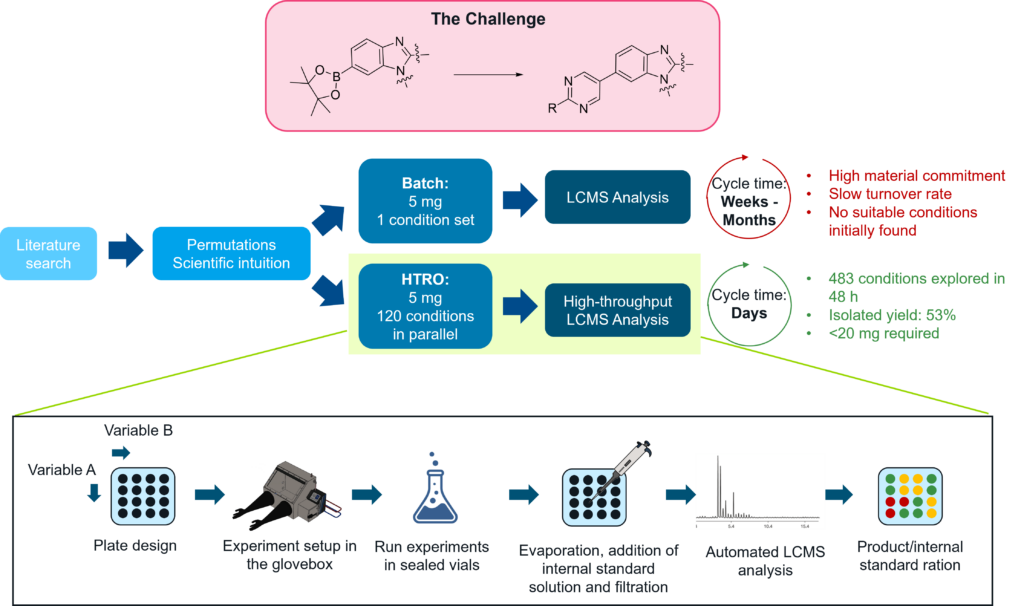Driving Discovery Through Miniaturized High-Throughput Chemistry

When chemists approach the formation of a new bond, they often choose reaction conditions that they (or their colleagues) are familiar with and have worked for them in the past. Typically, they would first run a test reaction on a small scale (5 mg), evaluate the outcome and make changes to the reaction conditions that they believe will give a more favorable result. This iterative process is then repeated ad infinitum until they are satisfied with the result, and the desired product is isolated. But what happens when the typical conditions give little to no product? Or there is little precedent for the desired transformation? Or the number of variables that require optimization is simply too high?
The development of high throughput experimentation (HTE) has been a transformative technique in the pharmaceutical industry as it allows for the investigation of many variables at the same time. At X-Chem, we’ve developed a specialized team for high throughput route optimization (HTRO) that works alongside other chemists to unlock synthetic roadblocks by using HTE.

The HTRO team at X-Chem leverages expertise in organometallics, catalysis, method development and design of experiments to uniquely tailor screens to every chemist’s needs. In addition to HTRO for photoredox, hydrogenation and reductive aminations, transition metal-catalyzed cross-coupling reactions are by far the most requested transformation for our team. Thus, we have established a streamlined library of catalysts and ligands that we can rapidly deploy in fit-for-purpose screens. We design these screens based on literature precedent, our chemist’s knowledge and our own experience. We strive to include outside-the-box examples in our screens to provide opportunities for engineered serendipity.
To achieve our throughput while remaining conscious of material constraints, we combine ChemBeads technology (developed by AbbVie) with a “pool and split” approach to our experimental design (introduced by BI). ChemBeads, a form of solid dilution, allows us to accurately dispense sub-milligram amounts of material, which in turn minimizes the material investment by the chemist requiring HTRO. Typically, a full 96 well plate requires less than 20 mg of material. Reaction conditions are rapidly identified by applying a combinatorial “pool and split” approach to the design of our screening platforms. By combining metals, ligands and other reactants into so called “pools” based on their chemical properties, we can survey hundreds and even thousands of unique conditions in 96 individual reactions. After identifying the pools that provided the highest amount of product, we identify the right conditions by deconvoluting the pools into their individual components. We found that this approach provides conditions robust, scalable and reproducible by the chemists.
When it comes to maximizing impact and minimizing materials, the HTRO team has saved months of chemists’ time and grams of advanced intermediates. Our ability to cover the breadth of chemical space with the least amount of material has been an enabling tool for the X-Chem team, and we continue to grow our capacity every day.
The Importance of Selecting the Right CRO Partners for Drug Discovery Success
When it comes to drug discovery and development, having the right team and partners is critical for success. For a...
AI-Powered Building Blocks “ReadiBLOX” for DEL Synthesis
Drug Hunter recently wrote the article “Decoding DNA-Encoded Libraries for Drug Discovery.” Over the past two decades, DEL technology has...